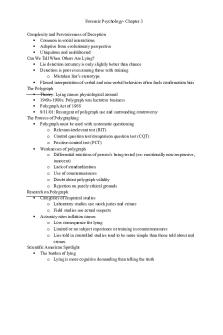Forensic 4 - Prof. Trinh, chapter guide. PDF

| Title | Forensic 4 - Prof. Trinh, chapter guide. |
|---|---|
| Course | Introduction to Forensic Science |
| Institution | Utah Valley University |
| Pages | 2 |
| File Size | 64.2 KB |
| File Type | |
| Total Downloads | 44 |
| Total Views | 149 |
Summary
Prof. Trinh, chapter guide....
Description
NAME: _____________________________________ CHAPTER 4 REVIEW QUESTIONS 1. What is physical evidence? • Physical evidence encompasses any and all objects that can establish that a crime has or has not been committed. • Can provide a link between a crime and its victim or a crime and its perpetrator.
2. What is the most important consideration in handling and processing physical evidence? • Investigators handle and process physical evidence in a way that prevents changes to the evidence. • Avoiding contamination, breakage, evaporation, accidental scratching or bending, improper or careless packaging.
3. What is the proper way to package charred debris from the scene of a suspicious fire? Why is such packaging recommended? • In airtight metal or glass containers to prevent the loss of accelerant vapors.
4. Biological materials should not be stored in airtight containers.
5. Name 5 likely sources of DNA evidence. • Soil, blood, glass, hair, fibers.
6. A piece of paper folded in a specific way to be used as an evidence-collection container is known as a(n) druggist fold.
7. Why should all items of evidence be placed in separate containers? • Packaging evidence separately prevents damage through contact and prevents crosscontamination.
8. What type of protective clothing and equipment should an investigator wear when handling potentially infectious material? • Double-gloved latex gloves and possibly chemical resistant clothing, Tyvek-type shoe covers, a particle mask/respirator, goggles, or face shields.
9. Name four situations in which the Supreme Court of the United States has ruled that a warrantless search is justified. 1. The existence of emergency circumstances. 2. The need to prevent the immediate loss or destruction of evidence 3. A search of a person and property within the immediate control of the person provided it is made incident to lawful arrest. 4. A search made by consent of the parties involved.
10. Success in the recognition and collection of physical evidence is determined primarily by what factor? a. Notoriety of the case b. Time available to the evidence collectors c. Skill of personnel processing the crime scene d. Type of evidence involved...
Similar Free PDFs

Forensic Psychology Chapter 4
- 4 Pages

Seminar 4 forensic evidence
- 5 Pages

Forensic Psychology Chapter 3
- 3 Pages

Chapter 4 Study Guide
- 4 Pages

Chapter 4 Study Guide
- 11 Pages

Chapter 4 Study Guide
- 9 Pages

Chapter-4 study guide
- 45 Pages

Chapter 11 Forensic Science
- 2 Pages

Chapter 4 Study Guide
- 9 Pages

Chapter 4 Study Guide
- 4 Pages

Forensic Psych Chapter 2
- 4 Pages

Chapter 6 Forensic Science
- 3 Pages
Popular Institutions
- Tinajero National High School - Annex
- Politeknik Caltex Riau
- Yokohama City University
- SGT University
- University of Al-Qadisiyah
- Divine Word College of Vigan
- Techniek College Rotterdam
- Universidade de Santiago
- Universiti Teknologi MARA Cawangan Johor Kampus Pasir Gudang
- Poltekkes Kemenkes Yogyakarta
- Baguio City National High School
- Colegio san marcos
- preparatoria uno
- Centro de Bachillerato Tecnológico Industrial y de Servicios No. 107
- Dalian Maritime University
- Quang Trung Secondary School
- Colegio Tecnológico en Informática
- Corporación Regional de Educación Superior
- Grupo CEDVA
- Dar Al Uloom University
- Centro de Estudios Preuniversitarios de la Universidad Nacional de Ingeniería
- 上智大学
- Aakash International School, Nuna Majara
- San Felipe Neri Catholic School
- Kang Chiao International School - New Taipei City
- Misamis Occidental National High School
- Institución Educativa Escuela Normal Juan Ladrilleros
- Kolehiyo ng Pantukan
- Batanes State College
- Instituto Continental
- Sekolah Menengah Kejuruan Kesehatan Kaltara (Tarakan)
- Colegio de La Inmaculada Concepcion - Cebu



